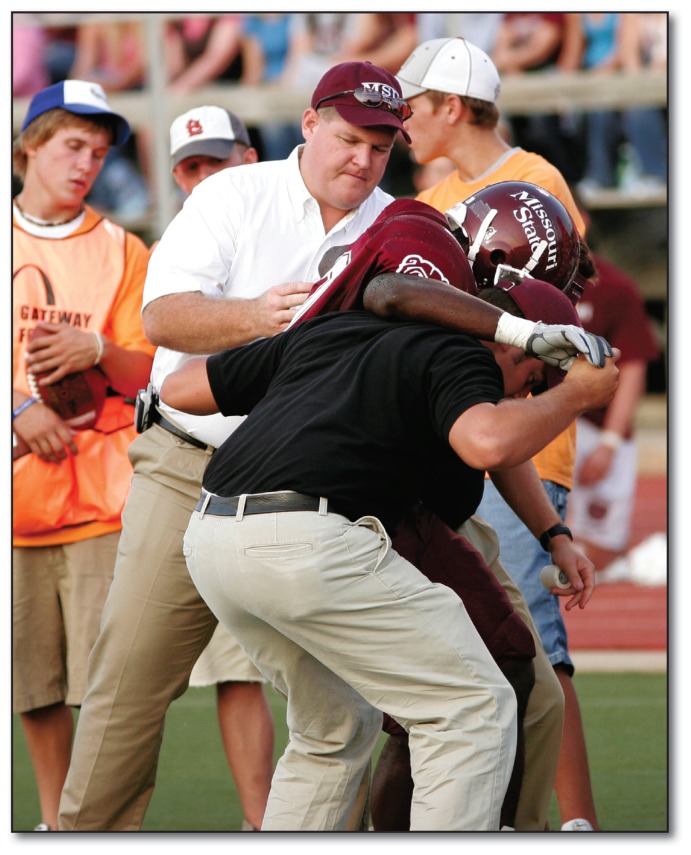As I was starting my family medicine residency at the University of Missouri-Columbia, Dr. James Kinderknecht became one of our faculty members. He came to Columbia to be a team physician at the University of Missouri, as well as a faculty member. After playing baseball at Missouri State University, and after talking to him about Sports Medicine, there was no doubt in my mind what I wanted out of my career. After my residency and a two-year Primary Care Sports Medicine/Academic Fellowship at the University of Missouri-Columbia, I was fortunate enough to return to Springfield. I have had the pleasure of practicing here for 12 years now.
When I have medical students and residents rotate through my clinic, a question that they always ask is; “Why should I consider a sports medicine fellowship?” My answer has changed through the years. This is related to the fact that the practice of sports medicine has grown and changed over the last 25 years.
Initially, primary care sports medicine was started by family physicians that had an interest in the care of athletes. There were three initial sports medicine fellowships; Ohio State University, Michigan State University, and UCLA. As doctors graduated from these programs, other fellowships started throughout the United States. Academic and community-based family medicine residencies were the main base for these programs, but well-known private orthopedic practices also started programs. These included the Hughston Clinic in Columbus, Ga., and the American Sports Medicine Institute in Birmingham, Al. The latter program was directed by Dr. James Andrews, a well known sports medicine orthopedist and researcher. By 1998, when I graduated from my fellowship, there were 53 primary care sports medicine fellowships in the United States. They are also based in Pediatrics, Emergency Medicine, and Internal Medicine. There is a match process that occurs for placement into specific fellowships.
To be considered a primary care sports medicine specialist, you have to obtain a Certificate of Added Qualifications (CAQ) in Sports Medicine. Prior to 1998, if at least 30% of your practice was athletic care-related, and had a certain level of yearly CME in sports medicine, you qualified to set for the CAQ test through the American Board of Family Medicine. To maintain your certification, you had to maintain your practice and CME levels. Dr. Bernard Griesemer, MD, one of my partners, has maintained his CAQ in this fashion. Since 1998, you must have graduated from an accredited fellowship to set for the CAQ test. Once you are certified, it must be renewed every ten years, and you must maintain your board certification in your initial specialty. Because of this change with the CAQ in 1998, there are now 143 sports medicine fellowships in the United States and eight fellowships in Canada. The American Board of Orthopedic Surgery followed this process two years ago and has a Sports Medicine CAQ that requires a fellowship to sit for the test.
Dr. Mahaffey is Head Team Physician for Missouri State University.
Recently, the Centers for Medicare and Medicaid Services (CMS) announced that they will recognize a specialty code for Primary Care Sports Medicine. This is a major step forward for our specialty.
Ten years ago, with the accreditation process, sports medicine fellowships were streamlined into one-year programs. Only a few now have a second year, which has to be based in academic medicine. The fellowship that I finished at the University of Missouri-Columbia, is a two-year fellowship. It did include an academic component, which led to a Master of Science in Public Health (MSPH) degree. Even though I do not practice public health, my academic background has been very helpful in teaching athletic training students, medical students, and residents.
So back to the question that I am always asked, “Why should I do a sports medicine fellowship?”
I was told that it was important to do a fellowship if you wanted to be a team physician at a major university or professional level. This still holds true. However, because the number of sports medicine specialists has increased, there are many more colleges at all levels that have primary care team physicians now. For many years, the team physician at the college and professional level was an orthopedist. Once primary care sports medicine became an entity, we partnered with orthopedists to give athletes care not only for musculoskeletal issues, but also for all of their health issues. With this partnership, the care of athletes has improved immensely, as well of our understanding of the demands and risks with sport participation.
Primary care sports medicine is not only the care of non-surgical musculoskeletal issues, but we have expertise in other medical concerns that active people tend to experience. These include heart problems that can lead to sudden death and heart injury with activity, concussion treatment, heat-related illness, diabetes, asthma among others. Athletes also have medical problems that any patient can have; this leads to always being vigilant. An example of this is a female athlete that I had the pleasure of seeing a number of years ago. She was experiencing recurrent stress fractures. After a full work-up, she was diagnosed with a prolactinoma and was treated medically with no recurrent problems. We are also trained in nutrition, supplements and drug testing, psychological issues, and exercise physiology.
Primary care sports medicine specialists, along with sports medicine orthopedic specialists, are the head of a team of experts, including certified athletic trainers, strength and conditioning specialists, physical therapists, chiropractors, nurses, nutritionists, psychologists, and massage therapists. Their expertise and the concept of a team approach make me a better overall physician as well.
With being a Team Physician at Missouri State University and with the Springfield Cardinals, it means using every part of my training to keep our athletes healthy. It is important to do everything possible to get our athletes playing. However, I stress to our athletes, coaches, and parents that we will not return an athlete into a situation where they can be hurt further. If they have “soreness” that they can play through, then it is appropriate to participate. I have had the displeasure of seeing patients later in life that tried to play through sports injuries; their lives have changed completely with these situations. I want our athletes to have good health after they leave competition and not regret their participation.
People always think that being a team physician is fun. I will be honest; it is, but for reasons that people may not realize. The most enjoyable part of my job is getting to know these athletes, both in competition and in their daily lives. Yes, you become a fan, but you have to separate that when making decisions regarding their health. Building trust with the athletes and with the coaches is vital when making decisions that may affect the outcome of a game or a season. Those friendships that are developed are the best part of my job. The worst part of being a team physician is the pressure in balancing the health of the athletes with the demands of major college and professional sports. Thankfully, most of the time these issues are not life and death, but to the athlete, it may feel like it is. Also, there are many hours spent that are not “billable” covering events; however, it is a vital part of a sports medicine practice. Specifically, at Missouri State University, we travel with the football team for all of their games. We also try to attend all postseason tournaments for our teams.
Even with the pressure of making decisions that not only affect your patient, but their teammates, coaches, agents, administrators, and management as a sports medicine specialist, it is a great specialty to practice and to a be a part of nationally. Through the American Medical Society for Sports Medicine (AMSSM), our specialty has pushed for better medical coverage of athletics and for evidenced-based solutions to athletic injury situations. Examples of this include the recent push for heat illness prevention and concussion management based on research instead of clinical symptoms and management protocols that were based on anecdotal evidence.
For me, having Dr. Kinderknecht come to Missouri to be a team physician was the best thing to happen during my training. I have never regretted my decision to become a sports medicine specialist. I look forward to work every day; not only for the challenge but for the unique relationships that are developed with the people that I have the pleasure to work with and for. And it is fun to see your patients succeed, not only in athletics, but in life.
Biography
Brian L. Mahaffey, MD, MSPH, MSMA member since 1999, is Director, St. John’s Sports Medicine in Springfield, Head Team Physician, Missouri State University and Team Physician, Springfield Cardinals.
Contact: Brian.Mahaffey@Mercy.Net




